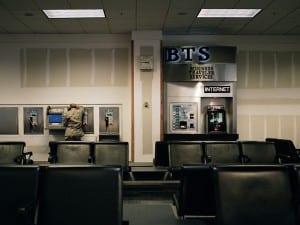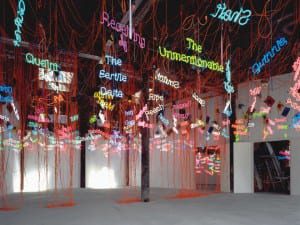Taking advantage of my friend’s car, I escaped the city this weekend to visit the unique environment of Yorkshire Sculpture Park. It’s a fantastic summer day out with the country’s best permanent collection from the movers and shakers of modernism such as Henry Moore and Barbara Hepworth, to contemporary giants of sculpture Anthony Gormley and Winter/Hörbelt. These are sculptures which belong in the open air, and it’s so rare to see them in such a setting – weathered by the elements in a way that only serves to enhance their beauty.
But that’s for another blog, I’d wanted to stop by the Sculpture Park to catch the new indoor exhibition, Unpopular Culture, after interviewing its curator, Grayson Perry earlier in July. Perry’s reputation precedes him, but what is special about his work as a curator is how irrelevant much of the preoccupations on Perry as an artist seem to be. Interviewing Perry, it is clear that he is attracted to the quieter side of art, the unassuming Britishness which makes up our national heritage and jars discordantly with the shouty sensationalism of contemporary art
The works on show question our view of the past and the invert the rose-tinted nostalgia of the good old days. With works including photography, painting and sculpture, Perry has included his own thoughts on many of the pieces and explains their appeal from among the Art Council’s extensive collection of home-grown art. Paintings such as Carel Weight’s The World We Live In, are typical of their time – kitchen sink representational art that highlights the hardships of a very particular moment in South London. Before gentrification, willowy figures amble aimlessly in a windswept yard, they are swayed by the wind in a manner that alludes to feelings of worthlessness and worklessness during the deep recession of the 1970s.
Photographical studies of the long-term unemployed in Newcastle Upon Tyne, and Martin Parr’s distinctive record of British grit, accompany the paintings and sculptures and visitors are invited to lounge in easy chairs and browse a collection of books on the period captured, and the artists involved. Perry himself has created two new works for the exhibition, one of which, Queen’s Bitter, showcases his trademark craftsmanship with an acerbic wit, and highlights that Perry is not as removed from the showmanship of contemporary art as he’d like us to believe, daubing the image of his alter ego, Claire, over the ceramic alongside further representations of our green and pleasant land. Unpopular Culture makes us aware of the flipside of British nostalgia – the grey times of unemployment and want that tempered the post-war UK. Perry notes: “Somehow people feel that they’re working towards a golden moment when everything will be all right. That doesn’t exist and people need to be reminded that life is a work in progress and there isn’t any solution at the end of it.” It’s a fascinating exhibition, expertly collected by one of British art’s leading figures in an effort to criticise itself.
There’s a full feature on Unpopular Culture, as well as the accompanying film screenings from the British Film Institute archive, Nostalgia for the Bad Times, in the new issue of Aesthetica out now – available at WH Smith, Borders and selected newsagents. Or click here to order your copy now
[Image credits: Henry Moore, Bryan Kneale, Carel Weight]




